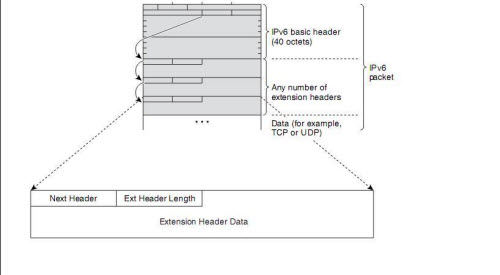|
IPv6 address a lot concerns and issues that are faced today in using IPv4. Cisco CCNA Certification
requires that a candidate must have a general overview of IPv6 and what
new features it brings into the world of networking. Here we will go
through some of the features of Internet Protocol Version 6 (IPv6).
The main feature of IPv6 are described in the sections below
Larger Address Space
IPv6 addresses are 128-bits long which gives us a theoretical address space of 3.4 x 1038
addresses, like IPv4 some address space is reserved for special purpose
but still there is a huge number of public routable addresses.
Aggregation
A larger address space allows for large address allocations to ISPs
and Organization. This allows them to use a single prefix for the entire
network making summarization easy and flexible which turn promotes
efficient and scalable routing.
New Improved Header Format
Optional and non-essential fields are removed from the IPv6 Header
and are moved the Extension Header that is placed after the IPv6 Header.
Fewer fields of fixed lengths mean Header overhead is minimized and
processing performance is improved. Another significant enhancement is
that all routers in a path do need to do checksum recalculation for an
IPv6 Packet instead error detection is handled by data-link layer
technologies checksums of the end-to-end connection at transport layer.
Figure 1 shows an IPv6 Header followed by Extension Header.


Allocation
IPv6 addresses are composed of two parts, 64-bit Network Prefix and
64-bit host part. The IPv6 address allocation follows a generally
acceptable assignment policy as shown in figure 1. This allows for an
efficient, hierarchical, and summarizable routing infrastructure.

Easy Address Assignment Methods
IPv6 has three assignment methods
- Autoconfiguration (Stateless)
An IPv6 host can configure a link-local address for each interface
automatically. By using ICMPv6 router discovery messages, a host can
also determine the addresses of routers, additional addresses, and other
configuration parameters.
Built-in Security
IPSec is built into IPv6 unlike IPv4 in which it is optional. IPSec
requirement is mandatory in IPv6 Protocol Suite Implementation. IPv6
networks have potentially more end-to-end security because of IPSec
availability on all nodes.
Extensibility
New futures for IPv6 can be added through the use of Extension
Headers. At present there are various Extension Headers specified for
QoS, Security, Mobility and Routing purposes.
Mobility
Mobility is built in to IPv6 which allows any node to use Mobile IP. Mobility is achieved using Mobility Extension Headers.
Better Quality of Service Support
IPv6 Header includes a new field called Flow Label that allows
routers to identify and provide special handling for packets that belong
to a particular flow. This field allows for easier identification of
traffic without doing any tricks even when the packet payload is
encrypted with IPSec.
Neighbor Discovery Protocol
Neighbor Discovery Protocol uses ICMPv6 messages to perform various functions such as
- Stateless Auto-configuration
- Neighbor Unreachability Detection
- Duplicate Address Detection
Transition
The transition options supported by IPv6 to transition from IPv4 are
another key feature of the protocol. Many Transitions mechanism are
available for different scenarios. They are mentioned below
- Dual-Stack
- Tunneling IPv6 over IPv4 networks
- Protocol Translation
Within each option are various different techniques to support transition. A few tunneling mechanism are mentioned below
- Automatic IPv4-Compatible IPv6 Tunnels
These rich features of IPv6 enable easy deployment, migration and operation of IPv6 networks.
More Related: Cisco, Why We Need IPv6 Now?
Notes: IPv4 vs IPv6
The v and number (4″ or 6″) in IPv4 vs IPv6″ refers to the
related protocol version number. IPv4″ is of course Internet Protocol
version 4″, and IPv6″ is subsequently Internet Protocol version 6″.
IPv4 is of course the older, more supported version of the internet
address procedure. But ultimately, there are no longer any free IPv4
addresses, meaning all of them have been occupied or taken up. What does
this mean exactly?
In a general sense, there will no longer be any alternative IPv4
addresses, directly meaning they will all be occupied and new users will
not be able to venture into cyberspace. Although the realistic
situation is not quite as dire.
Queue in IPv6, the latest Internet Protocol or address procedure. The
older IPv4 only supports a maximum 32 bit internet address, which
translates to 2^32 IP addresses available for assignment (about 4.29
billion total). IPv6 utilizes 128 bit web addresses, allowing a maximum
2^128 available addresses:
340,282,366,920,938,000,000,000,000,000,000,000,000; which if you
couldnt already tell is a very big number.
So basically the IPv4 protocol has run out of available addresses
which is why most websites or internet servers are adopting the newer
IPv6 protocol. In most cases, the two versions are compatible. This
contrast between the two protocol versions is exactly whats being
referred to when IPv4 vs IPv6″ is mentioned.
Reard more:http://blog.router-switch.com/2012/01/main-feature-of-ipv6/
09-01-2012, 08:36
Geschreven door karenluo87 
|
